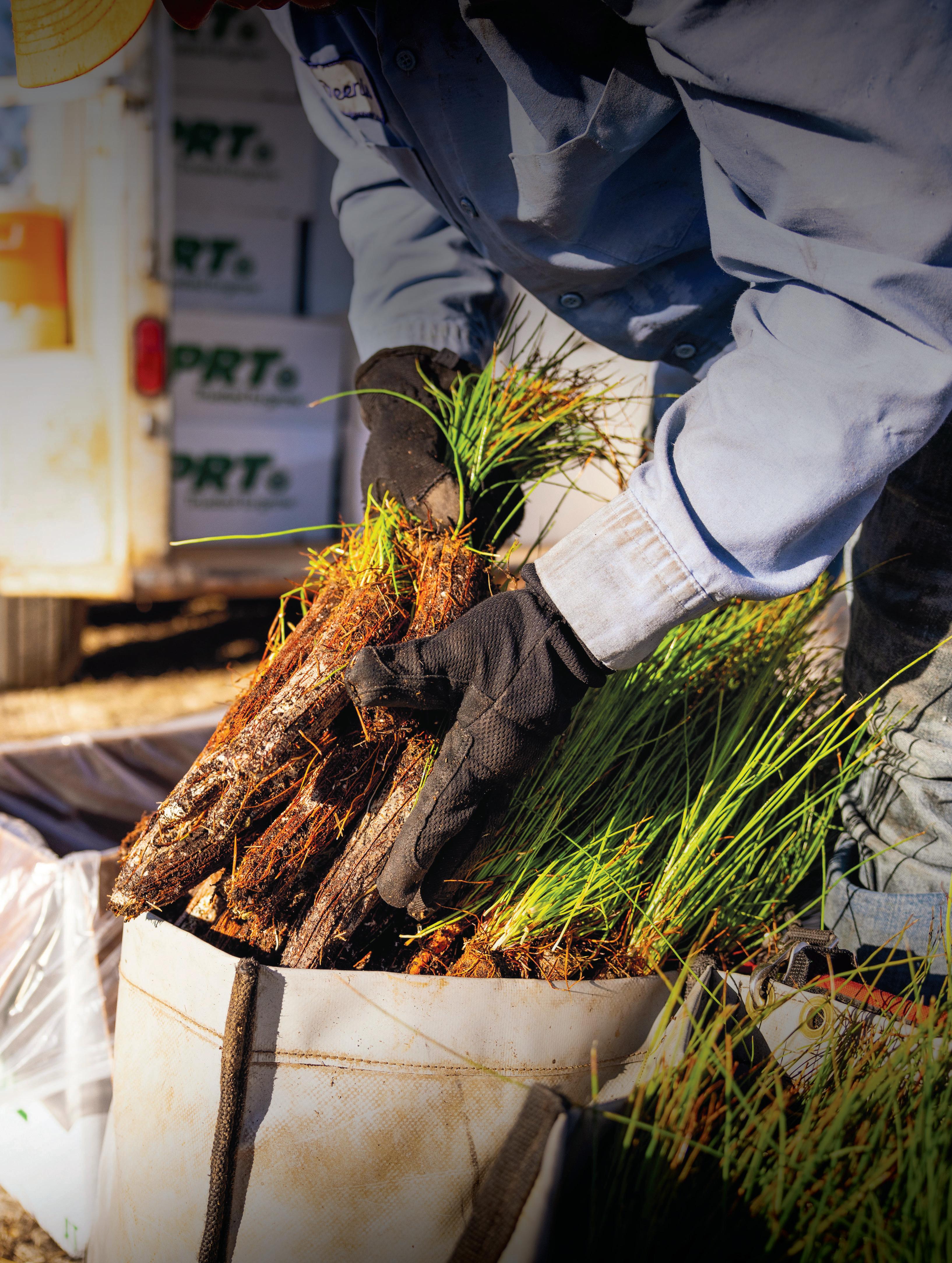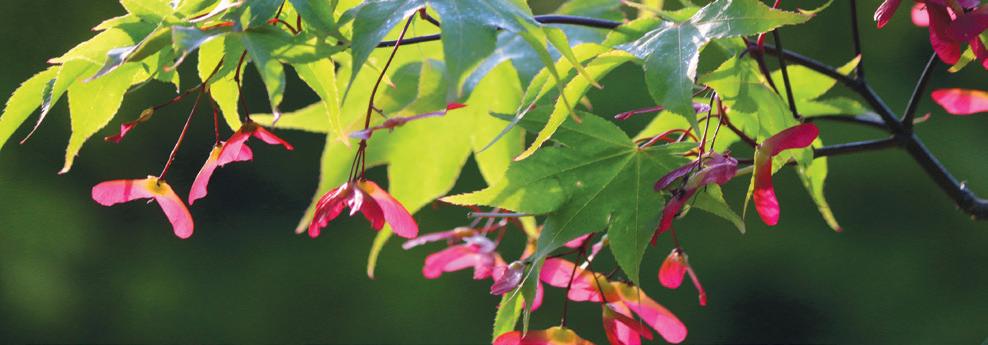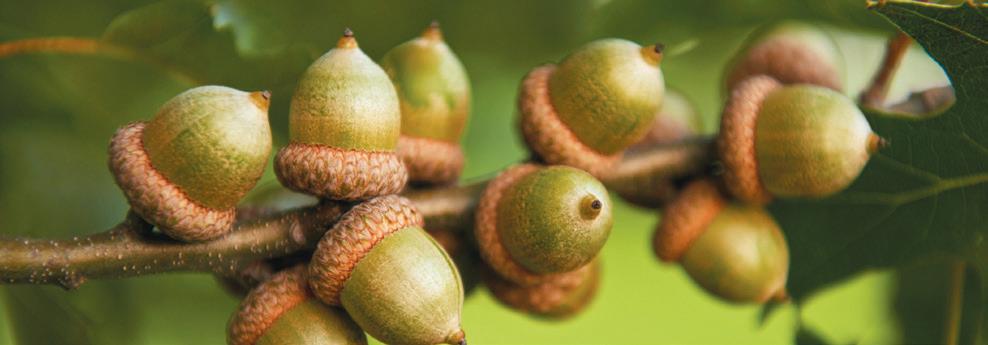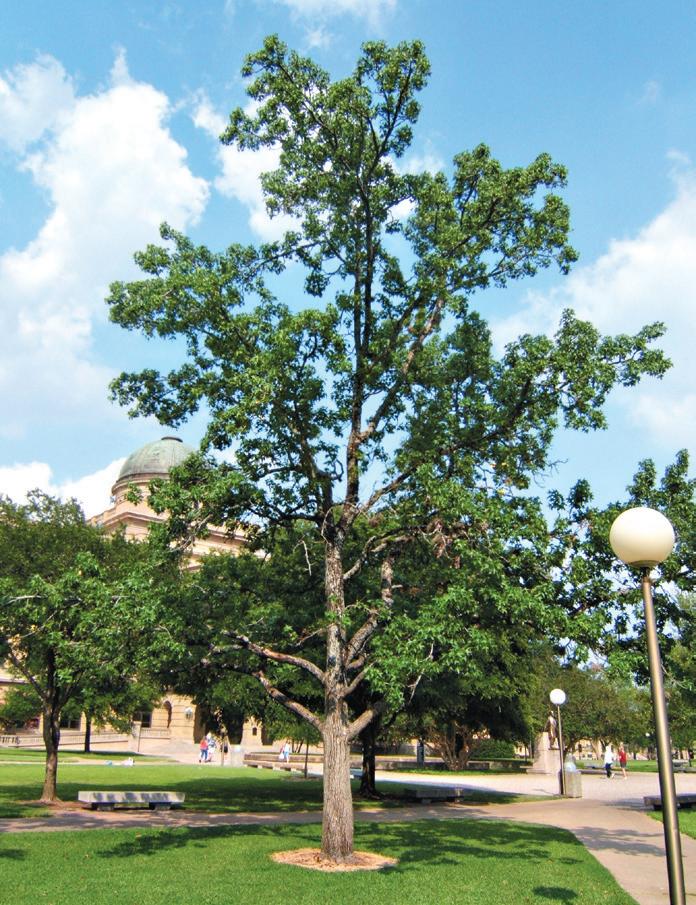A SWEEPING EFFORT TO RESTORE LONGLEAF FORESTS

MAY/JUNE 2023 • ARBORDAY.ORG
OVER THE PAST 18 YEARS, I have had the pleasure of working closely with urban foresters and community tree planting organizations around the country. The Arbor Day Foundation’s Tree City USA program has fostered these connections, and my attendance at the annual Partners in Community Forestry Conference has strengthened those ties.

In 2019, this network grew — stretching across the globe — with the Tree Cities of the World program. Based on the Tree City USA platform, this program came to life on a global scale through a partnership with the UN Food and Agriculture Organization.

With so much to learn and share in the urban forestry space, I’m excited to share that we will be cohosting the 2023 World Forum on Urban Forests this fall. This conference, another partnership between the Foundation and the United Nations, will bring together those who plant, nurture, and celebrate trees in cities and towns worldwide. The Partners in Community Forestry Conference and Alliance for Community Trees Day will also be woven into the event.
The forum will be held in Washington, D.C., on October 16–20, with plenty of opportunity to discuss how urban trees can create more resilient, healthy, and inclusive cities in different parts of the world. This is the level of connection that will foster inspiration and collaboration as we push beyond the status quo and strive to plant more trees where they are needed most.
I encourage any of our members interested in the world of urban forestry to join us for this remarkable gathering. Watch for more details at arborday.org/pcf
A Gift That Grows
Commemorative trees help celebrate loved ones
OF ALL THE RELATIONSHIPS IN OUR LIVES, the ones we share with our parents are particularly special.
The Arbor Day Foundation’s Trees in Celebration and Trees in Memory programs provide an opportunity to honor that bond. Trees are planted in a forest on behalf of a loved one, and a certificate or card is sent to commemorate the planting.

Ava Clarke, a supporter and employee of the Arbor Day Foundation, recently had trees planted in honor of her mother.

“Growing up in Montana, nature is incredibly important to me. I have seen the effect of forest fires, and it is devastating to see the landscape transform from one that is lush with trees and wildlife to one that is barren and burnt,” Ava said.
“My mother has done so much for me throughout the years to raise me and to help me grow as a person. For Mother’s Day last year, I wanted to give her a living representation of what she has done for me by planting trees in her honor,” she added.
Each year, the number of U.S. forests in need of replanting grows. The Arbor Day Foundation’s commemorative programs planted 2,801,510 trees in 2022 alone — helping drive this important work forward.
Whether you’ve planted commemorative trees in the past, or plan to do so in the future, use the hashtag #MyFamilyTree to share your giving on social media and inspire others to do the same.
2 ARBOR DAY • May/June 2023 • 888-448-7337 • arborday.org On the cover: Longleaf pine seedlings are prepared for a planting in Florida. FOLLOW US AT facebook.com/arborday
ARBOR DAY JOURNAL
ARBOR DAY FOUNDATION CHIEF EXECUTIVE, Dan Lambe
An early snapshot of Ava Clarke and her mother, Amy.
The Buzz About Our Seasonal Help

Hives of honeybees lend a hand each spring at Arbor Day Farm
WITH AN APPLE ORCHARD THAT SPANS MORE THAN 20 ACRES, Arbor Day Farm takes pollination seriously. That’s why the orchard staff brings in as many as 50,000 honeybees from a local beekeeper in mid-April each year.

These tiny temporary employees are critical to the success of the orchard, and they are a natural choice for the job. “There are a lot of different pollinators. You have wind, insects, birds. But historically, a honeybee is far and away the best kind of pollinator,” said Ben Heusinkvelt, grounds and orchard manager at Arbor Day Farm. “A honeybee will fly to every flower in its sight before moving to a different area. So you know the bee will land on maybe 50 to 60 flowers on a tree before it moves to the next tree.”
The exact timing of their arrival is completely up to nature. “We usually bring them in when the buds on the trees are at the pink stage. When the flower buds are pink, that basically means the petals are about to open. You want to bring the bees in about a day or two before that happens so they can acclimate to the space. If they don’t know where they’re at, they’ll send out scouts to find flowers and map out the area. So it’s best to get them used to the area a little bit,” he said.
Once they arrive, the honeybees work sunup to sundown until the last of the apple trees is done blooming. A total of 22 different varieties of apple trees can be found throughout the orchard — all blooming at slightly different times — so the entire process takes approximately three weeks.
Interested in planting an apple orchard in your backyard? Head to arborday.org/backyardorchard to find information to help you get started.
The goal? A bumper crop of delicious apples. That’s why it’s so important that the bees are ready to get to work as soon as the first bloom bursts open — because that first flower is critical. Apple blossoms appear in whorls (or clusters) of five, with the center flower being the first to unfurl. According to Ben, “the first blossom to bloom is called the king blossom. And that’s going to bear the best apple out of that cluster of flowers. And you really don’t want to miss the king blossom pollination.”
Once these busy little bees have made their way through the orchard, they punch their timecards and head back to their home field … a job well done. The fruits of their labor will then ripen each fall, creating apple-picking memories at Arbor Day Farm that will last a lifetime.

ARBOR DAY • May/June 2023 • 888-448-7337 • arborday.org 3 FOR RESERVATIONS TO STAY AT LIED LODGE: arbordayfarm.org • 800-546-5433 Nebraska City, Nebraska
Restoring a Treasured Landscape
Longleaf pine forests are rebounding, thanks to member support

our hundred years ago, the American Southeast contained a dazzling array of life. Prehistoric gopher tortoises, tiny flatwoods salamanders, red-cockaded woodpeckers, and countless other rare species all lived in harmony in the region’s longleaf pine forests.
But as new settlers took root, these thriving forests were harvested for the building of homes, ships, and railroad tracks. Fire suppression further limited their growth. As a result, just 5 million of their original 90 million acres remain intact today.
Though much of this landscape has been lost, an equally massive effort is now underway to save it. The Arbor Day Foundation is partnering with organizations across the Southeast — including The Longleaf Alliance — to plant millions of new seedlings where they’re needed most.
Joining Forces
Longleaf forests have a unique appearance. Their trees grow far apart, with grasses and wildflowers
An Expansive Range
Longleaf forests are found in nine states, including Texas, Louisiana, Mississippi, Alabama, Georgia, Florida, South Carolina, North Carolina, and Virginia.
sprouting up in the large, open spaces between them. These grassy forests are filled with thousands of species found nowhere else on the planet. Roughly 1,000 different plants grow within them, including orchids, meadowbeauties, sundews, and venus flytraps. And there are plenty of everyday species that call the forest home, too — like fox squirrels, quail, and deer.
“It’s one of the most biodiverse systems in North America. Just in the ground cover of really highquality longleaf sites, you can have over 100 species within a quarter acre,” said Carol Denhof, president of The Longleaf Alliance.
Controlled fires are a critical part of the ecosystem.
“You run a fire through one of these forests, and within just a few days, you see green sprouts coming up from the grasses. It’s like rebirth, in a way,” she said.
“It’s just endlessly fascinating to study. I’ve been able to see longleaf forests from Texas, to Florida, to Virginia, and they’re all different in their own little way.”
4 ARBOR DAY • May/June 2023 • 888-448-7337 • arborday.org
The Longleaf Alliance was founded in 1995 to act as a conduit between private landowners, government agencies, conservation groups, and researchers across the Southeast interested in managing and restoring longleaf pine forests.
Because 55% of the forest’s natural range is located on private property, providing landowners with financial assistance and free seedlings to plant is a crucial part of this effort.
Funding from the Arbor Day Foundation has allowed The Longleaf Alliance to distribute 15 million seedlings to landowners over the past four years. This is a “drastic increase” for the organization, Carol said — previously, it was averaging less than 3 million seedlings per year.
“All the landowners that we get to engage with on a daily basis are so passionate and dedicated to what they’re doing with their properties,” she added. “They’re very appreciative of that assistance.”
Protecting animal and plant life is the primary goal of this work. But there are also a myriad of other benefits that stem from reforesting the land, including providing clean drinking water for millions of residents.
“A healthy forest system helps filter the water in our aquifers and groundwater. It prevents water loss from runoff,” Carol said. “You want water to soak into the ground, versus just rolling off like on a parking lot. Even a pasture doesn’t absorb the same amount of water that a forest with native ground cover can.”
Longleaf pine trees are tall and resilient, with sturdy wood that can stand up against severe weather better than other varieties. They also live an average of 250 years. That means they’re capable of storing more carbon for longer periods of time, bettering the environment for us all.
Funding from the Arbor Day Foundation has allowed The Longleaf Alliance to distribute 15 MILLION SEEDLINGS to landowners over the past four years.

Carol said she couldn’t be more grateful for Arbor Day Foundation members, who are helping bring longleaf ecosystems back to life across her home state of Georgia and beyond.
“Their continuing support is so important. We appreciate all that they do to help advance these types of programs, getting more trees in the ground,” she said.
Do you or someone you know have land that could be restored to a longleaf pine ecosystem?
Visit longleafalliance.org or call 334-427-1029 to learn how you can get involved.

ARBOR DAY • May/June 2023 • 888-448-7337 • arborday.org 5
A new longleaf pine forest grows in Florida.
Champion of the Earth
Recognition for one partner’s efforts to protect the forest and honor tradition in the Andes Mountains

CONSTANTINO (TINO) AUCCA IS A TRAILBLAZER in the restoration efforts of South America’s rare and wonderful Polylepis forests. And as the president and co-founder of Acción Andina, he is a trusted tree planting partner of the Arbor Day Foundation. Tino is also among the latest recipients of the UN Environment Programme’s Champions of the Earth award.
Tino is a leader who inspires through action, and that shows through his commitment to being onsite planting trees. “Leaders must be role models, working with the people, providing inspiration along with action,” Tino said. “The energy passes between the leader and the people and back again. They feel happy seeing
Do you know someone doing great things for our world through trees? Share their story at arborday.org/treechampion
active, involved leaders. This energy and hope is so powerful for all of us.”
He knows what it takes to reforest one of the most fragile ecosystems in the world, and he integrates a centuries-old philosophy into his work. When asked about it, he said, “I am pleased that I can carry the message of Ayni and Minka — the ancient Inca principles of working together for the common good — to global audiences. This is not just an ancient message. It is a timeless and urgent message for everyone everywhere if nature and people are to survive.”
The Arbor Day Foundation is excited to celebrate Tino’s recognition as well as the legacy he is building.
Tino can often be found onsite, planting trees and engaging with local community members.
Leaving a Legacy May Be Easier Than You Think
TREES THRIVE FOR GENERATIONS, and so can your support of the Arbor Day Foundation when you establish a charitable gift annuity. As you receive consistent retirement income, your gift will leave a legacy for years to come.

Charitable gift annuities offer retirement income with a large portion of it tax-free. For example, Patricia, age 84, made a $75,000
LEARN MORE. NO OBLIGATION.
Please provide me with a confidential quote for an Arbor Day Foundation Charitable Gift Annuity.
Birth Date / /
I am considering a gift annuity of $
Name Address
City/State/Zip
($10,000 minimum)
Telephone ( ) Best time to call

Email
donation to the Arbor Day Foundation for a charitable gift annuity. She receives $5,700 (7.6%) annually, with $4,685 of it tax-free. And at tax time, she can take a $40,785 charitable deduction that can be spread over several years if necessary.

According to the SECURE Act 2.0, individuals over 70½ can make a one-time $50,000.00 Qualified Charitable Distribution (QCD) from an IRA account to a charitable gift annuity. This distribution will count toward the donor’s required minimum distribution for the year and will not be recognized as ordinary income for tax purposes. Rather, taxes will be spread out and paid on the individual gift annuity payments.
To receive additional information about charitable gift annuities, please mail in the coupon, call Erin Mousel at 888-448-7337, ext. 9614, or email giftplanning@arborday.org.
to: Arbor Day Foundation
N. 12th St. • Lincoln,
Mail
211
NE 68508
08773 100
Photo Credit: Salesforce
TREE BASICS
Supporting Our Feathered Friends
IN 2019, RESEARCH REVEALED that the U.S. and Canada had lost nearly a third of their birds — 2.9 billion all together — since 1970.
As bleak as this picture may be, it’s not too late to make a difference for our local bird populations. You can plant trees, and take other easy steps, to help them thrive.
How Birds Help Us
Birds contribute to our food supply by pollinating 5% of all plants grown for human consumption. They also quietly go about keeping insect populations in check! Here are some impressive statistics, courtesy of the Garden Club of America:
Fruit-Bearing Trees
Cherries
Dogwoods
Plums
Viburnums
Serviceberries
Apples
Crabapples
Eastern Redcedars
Hackberry
Hawthorns
Sumacs
A Baltimore oriole can consume 17 hairy caterpillars in a minute.

Ways You Can Help
A house wren feeds 500 insects to its young every summer afternoon.
A pair of flickers consider 5,000 ants a mere snack.
• Plant trees with fruit, nuts, or seeds that attract birds. See recommendations at right.



• Plant trees that are different heights at maturity. This will help attract birds that prefer different niches for feeding and nesting.
• Set out a bird bath in your yard and keep it filled with fresh water. In the winter, keep it free of ice with a commercially available bird bath heater, car dipstick heater, or aquarium heater.
• Hang a bird feeder. Though different birds prefer different seed blends, black oil sunflower seeds are enjoyed by most varieties.
• In safe locations, retain dead trees. Woodpeckers and other cavity-nesting birds depend on them for nesting and breeding.
Nut and Acorn-Bearing Trees

Buckeyes
Butternuts
Black Walnut
Chestnuts
Hazels
Hickories
Oaks
Trees With Attractive Seeds
Alders
Birches
Firs
Hemlocks
Maples
Spruces

ARBOR DAY • May/June 2023 • 888-448-7337 • arborday.org 7
American Sweetgum
Liquidambar styraciflua
NATIVE TO THE SOUTHEAST
UNITED STATES, the American sweetgum has become a prized specimen in parks, campuses, and large yards across the country. Its standout quality is its bright green, glossy leaves, which provide beautiful color each autumn.


For best results, this tree should be planted in a large, open area with minimal pollution.
LEAVES: Bright green, glossy, and star-shaped, turning red, purple, or gold in the fall.
FRUIT: Brown, woody, burlike globes roughly 1" to 1½" in diameter.
BARK: Grayish-brown with deep, narrow furrows.
FORM: Medium to large, reaching 60' to 70' tall at maturity with a 45' spread. Pyramid-shaped while young, becoming rounded with age.
WILDLIFE VALUE: The seeds of the American sweetgum are enjoyed by a wide range of birds and small animals, including squirrels and wild turkeys.
GROWTH RATE: Medium, with height increases of 12" to 18" per year.
PLANTING: Requires full sun and a large space with no overhead utility lines. Tolerates most soil types, but should not be planted on polluted sites. Suitable for hardiness zones 5 to 9.
We guarantee delivery of healthy trees to our members. Please check ordering deadlines and shipping dates at arborday.org/shipping. If you need to contact us about your trees, call 888-448-7337, email us at info@arborday.org, or drop us a note at Member Services, Arbor Day Foundation, 211 N. 12th St., Lincoln, NE 68508. We want your tree planting efforts to be successful!

To purchase or learn more about this tree and others, visit arborday.org/americansweetgum or scan this QR code.

official publication of
© 2023 Arbor Day Foundation. The Foundation sometimes exchanges mailing lists with selected organizations with offers of interest to our members. If you do not want your name included, just write, email, or call Member Services and tell us not to exchange your name.

50136501 An




















